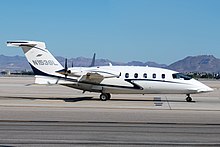Piaggio Aerospace
| Piaggio Aerospace SpA
|
|
|---|---|
| legal form | Società per Azioni |
| founding | 1884 |
| Seat | Villanova d'Albenga , Italy |
| management | Renato Vaghi, CEO |
| Branch | Aircraft construction |
| Website | piaggioaerospace.it |
Piaggio Aerospace SpA (until 2014 Piaggio Aero Industries ) is an Italian aircraft manufacturer based in Villanova d'Albenga .
history
Piaggio began manufacturing aircraft in Sestri Ponente during the First World War , after taking over the Officine Aeronautiche Francesco Oneto in 1915 . At first it produced Caproni bombers under license, then in 1923 the first own model was created, the Piaggio P.2 . From 1924 the Dornier Wal was also built under license . Later, Piaggio became known for its larger models, including the Piaggio P.23R transport aircraft , which set two world records, and the four-engine Piaggio P.108 bomber , which was used in World War II. The most important production location at that time was the Pontedera airport near Pisa .
Well-known types of the post-war period were the Piaggio P.149 training aircraft, used by several air forces, and the Piaggio P.166 light multi-purpose aircraft . In 1998, Piaggio's aircraft construction division was spun off into a separate company called Piaggio Aero Industries . Since then it has been owned by the families of Piero Ferrari and Josè Di Mase. In 2006 the companies Mubadala Development Company from the United Arab Emirates and the Indian Tata Group became shareholders. The company has been solely owned by the Mubadala Development Company since 2014. It was in Piaggio Aero Space renamed and moved its headquarters from Genoa Airport to Albenga Airport , which in the past as a factory airfield had been used. A service center will remain in Genoa.
Today Piaggio Aerospace manufactures aircraft components as a supplier and produces the turboprop aircraft Piaggio P.180 and its unmanned version P.1HH HammerHead .
According to aerotelegraph, Piaggio Aerospace filed for bankruptcy on November 22, 2018.
Products
Since 1923 Piaggio (Aerospace) has developed the following models:
- P.2 , single-seater hunter, 1923
- P.3 , night bomber, 1923
- P.6 , catapult aircraft, 1927
- P.7 , experimental seaplane, 1928
- P.8 , Maritime Scout, 1928
- P.9 , touring plane , 1929
- P.10 , three-seater maritime patrol aircraft, 1932
- P.11 , two-seat trainer aircraft, 1933
- P.12 , twin-engine touring aircraft, 1933
- P.16 , heavy bomber, 1934
- P.23 , twin-engine long-distance transporter, 1935
- P.23R , record-breaking aircraft, 1936
- P.32 , twin-engined bomber, 1936
- P.50 , four-engine bomber, 1937
- P.108 Bombardiers , bombers, 1939
- P.111 , single-engine experimental aircraft for altitude tests, 1941
- P.119 prototype fighter, 1942
- P.133 version of the P.108B, not flown
- P.136 Gabbiano (seagull), amphibian, 1948
- P.148 single-engine trainer aircraft, 1951
- P.149 trainer aircraft, 1953
- P.150 trainer aircraft (prototype), 1952
- P.166 twin-engine multipurpose aircraft, 1957
- P.180 Avanti (→ Piaggio Aero Industries P.180 Avanti), business jet, 1986
- RP.196 , project
- PD.808 twin- engine transporter, 1964
- P1XX , project
See also
Web links
- Piaggio Aerospace SpA website (Italian, English)
Individual evidence
- ↑ mubadala.ae: Aerospace Assets PiaggioAero SpA , accessed October 27, 2010
- ↑ Piaggio is now completely Arabic , accessed on September 24, 2015




